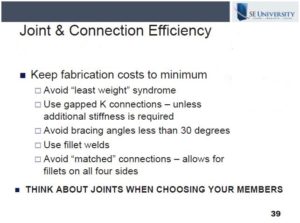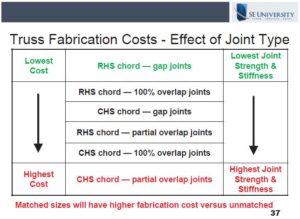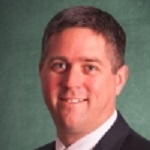In March 2019, SE University welcomed Geoff Blumber and Ravi Ozarker, PE, P.Eng., from Hexagon PPM, to present Avoiding Vibration Issues in Your Structure. Geoff designated the James Mirabal, P.E. Endowed Scholarship in Civil, Architectural and Environmental Engineering at the University of Texas at Austin (https://endowments.giving.utexas.edu/james-mirabal-p-e-endowed-scholarship-in-civil-architectural-and-environmental-engineering/) for the SEU Speaker Inspires donation of the month.
Geoff shared: “During my time at UT, Jason Mirabal was not only a classmate, but also a friend. His father, James is not only a PE but also a 1st generation college graduate who inspired his children to plan and persevere in their efforts to fund and complete their college degrees. His positive example inspired not only his children but also their classmates (including myself as the first in my family to attend college). This endowment was established to pay forward that inspiration and persevering example to assist others that are the first in their family to attend college. Any 1st generation college students pursuing a degree in Civil or Architectural Engineering from the University of Texas is eligible to apply.”
Thank you, Geoff, for helping structural engineers with your SE University session, and for your designation of the the James Mirabal, P.E. Endowed Scholarship in Civil, Architectural and Environmental Engineering at the University of Texas at Austin as our SEU Speaker Inspires Organization of the Month!
SE University began the SEU Speaker Inspires program in 2015 as a way to “pay it forward”, enabling our speakers to designate a charity/organization of their choice for SE University to make a donation to help improve our world.
14 Mar 2019
ASCE Offers New “Career by Design” Online Portal
ASCE has recently launched a new online platform available to its members designed to aid young engineers in career development. Career by Design was launched earlier this year and offers society members access to a wealth of targeted content, tools, tips, and opportunities for advancement. Login and check out relevant discussion boards, skills coaching, and advice on achieving licensure. Connect with other ASCE Younger Engineers and become a voice within the profession.
Also, included in this platform is Mentor Match which pairs the user with an expert who can guide you in the right direction. After setting up your profile, you can easily follow the steps outlined by ASCE to gain valuable advice and insight from a well-matched senior engineer.
Getting involved in the profession may seem intimidating at first, however this new online portal can get you plugged in and offer insight when career-oriented questions arise. Don’t miss out on this benefit available free to all ASCE members!
13 Mar 2019
Resources for Truss Connection Design
Typically, engineers rely heavily on Chapter K of AISC 360 for design guidance for HSS connection designs. However, there are many additional resources available including additional design examples and principles which are not referenced or included in AISC 360.
In the January 2019 SE University session, Brad Fletcher, SE, from Atlas Tube, gave a presentation on HSS Truss Connections: The Ts, Ks, and Ys of It All. Brad reviewed ways that HSS truss joint configurations affects the strength and stiffness of the overall truss, as well as how the fabrications costs of the truss relate to the truss joints connections and details.
Brad offered several resources for the design of steel trusses, connections, and multi-planar trusses. Of course, AISC 360 offers design guidance in Chapter K for HSS connections, however AISC Design Guide 24 adds further insight for HSS connection design. Brad noted this design guide will be enhanced and released again later this year.
CIDECT (International Committee for the Development and Study of Tubular Structures) also offers great examples and principles which may not be covered in the AISC design guides. The 9 CIDECT design guides are available for free download on the AISC website, and further support can be found directly from CIDECT.
Steel Tube Institute also offers several online tools as well as HSS Design Manuals. These online tools include spreadsheets as well as HSS CONNEX which code checks your joint configuration. Some items are available for free to members while others may be purchased without membership.
Having and using these additional resources can give an engineers more insight into the intricacies of HSS joints and connection design which can help to increase truss strength and stiffness while minimizing fabrication costs. Online tools are especially helpful to code check individual connections and save valuable design time on your next project.
25 Feb 2019
Efficient HSS Truss Connection Design
When designing trusses, do you often include joint connections in the main design, or is it more an afterthought once the main structural members are selected based on strength? Often times, engineers will focus on minimizing the weight of the truss members, without regard to the joint design details, and this can prove to be a costly error.
In the January 2019 SE University session, Brad Fletcher, SE, from Atlas Tube, gave a presentation on HSS Truss Connections: The Ts, Ks, and Ys of It All. Brad reviewed ways that HSS truss joint configurations affects the strength and stiffness of the overall truss, as well as how the fabrications costs of the truss relate to the truss joints rather than simply the overall weight of the truss.
Brad highlighted some important rules of thumb which can be used to design efficient trusses. As a general rule, Brad suggested aiming to design chord members to be relatively stocky (low D/t or B/t) while branch members should have a larger diameter, but thinner walls (high D/t or B/t). Using this recommendation, you can avoid “thick to thin” welding and an added benefit of less surface area at the chord to reduce painting costs.
Brad also offered some additional pointers to keep fabrication costs low, as shown in the slide below. As he points out, engineers often focus only on reducing the steel tonnage of their trusses, however, there are many ways to design a less costly truss by considering the joints specifically when designing the overall truss.
When a more costly truss connection is necessary to improve strength or stiffness values, Brad offered the following step-wise approach to consider costs while improving strength. As you can see in the slide, using Rectangular Hollow Section chords with gap joints have the lowest costs and lowest strength and stiffness values, while Circular Hollow Section chords with partial overlap joints have the highest costs and highest strength and stiffness values.
Taking steps to avoid costly Complete Joint Penetration welds and overlapped joints can often save more than solely minimizing the overall chord and web member sizes. These guidelines presented are a great starting point to begin an efficient design which considers the effect of joint configuration on the cost of the truss.
25 Feb 2019
Improvements to ASCE 7-16 Wind Maps
Are you familiar with the changes to the wind provisions in ASCE 7-16? If you’ve taken the time to look at the wind maps, you may have noticed some significant changes to the contours and wind speed, but there are other changes that will affect your daily designs within the wind provisions. It is important to not only know what has changed, but why the changes were made.
In November 2018, Don Scott, SE, from PCS Structural Solutions, presented ASCE 7-16 Wind Provisions – Changes Affecting the Design Provisions. Don covered the changes to the new wind speed maps and explained how to determine the design wind speed. He also presented the changes to the roof pressure coefficients, and explained the effects of the new Elevation Factor.
Don was able to provide much insight as to what went into the changes to the wind speed maps and roof pressure coefficients. Since ASCE had not made changes to the non-hurricane wind speeds since 7-95, there was a significant increase in new anemometer locations and data gained from these locations. The new maps now reflect more regional variability in extreme wind climates. Wind speeds in the great plains remain unchanged, but for the rest of the country wind speeds have decreased, most significantly along the west coast. Also, new hurricane models have reduced the hurricane winds along the northeast coast, while the hurricane winds along the southeast coastlines remain unchanged.
Don offered two permitted web based tools that may be used to access wind speed data for various locations in the United States. The first option is the Applied Technology Council’s (ATC) WINDSPEED BY LOCATION website which available free of charge. The second option is ASCE 7 HAZARD TOOL which is available to registered members. This tool provides all design parameters specified by ASCE 7-16 for a given site.
While most of the country will appreciate some wind pressure reductions, there will be more regional variability nationwide than in previous editions of ASCE7 due to the new wind map contours. Overall, the new improvements made to the ASCE 7-16 wind provisions will result in more accurate reflections of the wind speeds being witnessed at various anemometer locations throughout the United States.
In February 2019, SE University welcomed back Matthew Rechtien, PE, Esq., Senior Assistant City Attorney with the City of Ann Arbor, to present Engineering Ethics Update and Miscellany. In 2017 and 2018, he designated the David and Maxine Fowler Endowed Excellence Fund at the University of Texas at Austin (http://www.caee.utexas.edu/alumni/gift/opportunites) for the SEU Speaker Inspires donation of the month, and he has chosen to do the same in 2019.
Matthew previously shared why he chose the David and Maxine Fowler Endowed Excellence Fund: “Dr. Fowler, with the support of his wife, Maxine, has been a mentor, advocate, and friend for twenty years. As a professor at the University of Texas for half a century, he has touched the lives of literally hundreds of other engineering students, engineers and others in a similar way. Dr. Fowler is a gentleman and scholar in every sense of those words. I am humbled to be able to contribute, in any way (but especially by, as he did, teaching my fellow engineers), to his legacy, including the David and Maxine Fowler Endowed Excellence Fund.”
Thank you, Matthew, for helping structural engineers with your SE University session, and for your designation of the David and Maxine Fowler Endowed Excellence Fund as our SEU Speaker Inspires Organization of the Month!
SE University began the SEU Speaker Inspires program in 2015 as a way to “pay it forward”, enabling our speakers to designate a charity/organization of their choice for SE University to make a donation to help improve our world.
In January 2019, SE University welcomed Brad Fletcher, SE, from Atlas Tube, to present HSS Truss Connections: The Ts, Ks, and Ys of It All. Brad designated the Alzheimer’s Association (https://www.alz.org/) for the SEU Speaker Inspires donation of the month.
Brad shared that he chose this organization because “My Dad had Alzheimer’s and my mom had dementia so I have firsthand knowledge on how challenging it can be.”
According to its website, “The Alzheimer’s Association is the leading voluntary health organization in Alzheimer’s care, support and research. Our mission is to eliminate Alzheimer’s disease through the advancement of research; to provide and enhance care and support for all affected; and to reduce the risk of dementia through the promotion of brain health.”
Thank you, Brad, for helping structural engineers with your SE University session, and for your designation of the the Alzheimer’s Association as our SEU Speaker Inspires Organization of the Month!
SE University began the SEU Speaker Inspires program in 2015 as a way to “pay it forward”, enabling our speakers to designate a charity/organization of their choice for SE University to make a donation to help improve our world.





